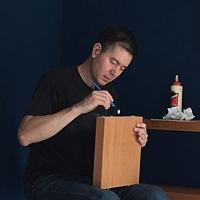Share your craft projects
Make new craft buddies
Ask craft questions
Blog your craft journey

Ron Stewart
866 posts
and
24 followers
in about 3 years
in about 3 years
More from Ron Stewart
Mini Tetrahedral Tensegrity Table Details #9: Finishing the Disks and Attaching the Pyramids
This is
part 9
in a
10 part
series:
Mini Tetrahedral Tensegrity Table Details
...
-
Disk Details--Attaching the Outer Support Wires
-
Finishing the Disks and Attaching the Pyramids
-
Tensioning the Wires and Completing the Project
...
- Disk Details--Attaching the Outer Support Wires
- Finishing the Disks and Attaching the Pyramids
- Tensioning the Wires and Completing the Project
I wanted to use glue to attach the pyramids to the disks, because I didn't want any visible fasteners. But it was very apparent that I would need something to help precisely position the pyramids and prevent them from shifting during glue up. I decided to use tiny alignment pins/holes.
I went back to my trusty disk template, marked the inside edges of the pyramid, and drilled 1/16" center holes.
I went back to my trusty disk template, marked the inside edges of the pyramid, and drilled 1/16" center holes.

To drill matching holes in a pyramid, I clamped it to the template.

Then I drilled the holes from below, making sure not to drill too deep.

That worked well.

For alignment pins, I could have cut short lengths of brad nails. But I'm a woodworker, so I fashioned
the pins from toothpicks. The toothpicks were too thick for the holes, but I chucked them in a drill
and spun them through sandpaper to reduce their diameter. Then I used my side cutters to cut them to
length. They weren't pretty, but they were good enough.


Now all I had to do was drill matching holes in the disks. My template made that easy, and in just a few seconds I had drilled three perfectly spaced holes in the bottom disk… in the wrong locations. Idiot! The pockets for the tensioning wire pockets had to be aligned, but not the pyramids. The alignment holes in the two disks needed to be rotated 60-degrees relative to each other.
I drilled three new holes in the correct location, and pulled out some sandpaper. I had to fill the unwanted holes with a sawdust/glue mixture.
At this point, I didn't trust myself not to fill in the good holes, so I taped over them.

Each bad hole was in a location with a different color shade, and one was right beside a dark grain line, so I had to create light and dark sawdust.

It worked out okay. I think some of my patch lifted when I did my final sanding (or I didn't add enough filler), because I can still see dimples in the finished table, but I don't really notice them unless I look for them.

After a final sanding and easing of edges, the disks were ready to finish. I wanted to darken the walnut a bit and warm up some of its grayness, so I tested a few finishes.
Brown dye (with one coat of Arm-R-Seal) was too dark and a bit muddy. (The piece on the right is unfinished.)

Zar Rosewood stain (plus one coat of Arm-R-Seal) looked pretty good, but maybe a bit too dark in spots.

The only other possible finish I had was an ancient can of Zinsser amber shellac. It looked really nice. It warmed up the walnut, didn't darken it too much, and it made the the wood glow. I decided to use it like a stain (wiping most of it off) with a gloss Arm-R-Seal topcoat. Gloss felt right for this project, and I thought it would show reflections of the pyramids, adding visual interest.

Before applying the shellac and poly, I had to mask off the pyramid base. I used 1/4" strips of painters tape for that.

I applied the shellac "stain."

Then I added three coats of Arm-R-Seal poly.

Because of the alignment pins, gluing on the pyramids was easy and drama-free.


Now I was ready for the final step: attaching and tensioning the wires.








